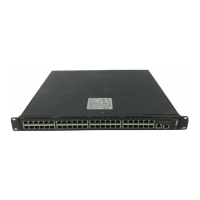Layer 2,3,IPv6+QoS Switch
_____________________________________________________________________________
Layer 2,3,IPv6+QoS Network Switch User Manual Version 0.1 Page: 66/970
6.2 Device Configuration Commands
6.2.1 Interface
6.2.1.1 show interface status
This command displays the Port monitoring information for the system.
Syntax
show interface status {<slot/port> | all}
<slot/port> - is the desired interface number.
all - This parameter displays information for all interfaces.
Default Setting
None
Command Mode
Privileged Exec
Display Message
Intf: The physical slot and physical port.
Type: If not blank, this field indicates that this port is a special type of port. The possible
values are:
Source - This port is a monitoring port.
PC Mbr - This port is a member of a port-channel (LAG).
Dest - This port is a probe port.
Admin Mode: Selects the Port control administration state. The port must be enabled in
order for it to be allowed into the network. – It may be enabled or disabled. The factory
default is enabled.
Physical Mode: Selects the desired port speed and duplex mode. If auto-negotiation
support is selected, then the duplex mode and speed will be set from the auto-negotiation
process. Note that the port's maximum capability (full duplex -100M) will be advertised.
Otherwise, this object will determine the port's duplex mode and transmission rate. The
factory default is Auto.
Physical Status: Indicates the port speed and duplex mode.
Link Status: Indicates whether the Link is up or down.
Link Trap: This object determines whether to send a trap when link status changes. The
factory default is enabled.
LACP Mode: Displays whether LACP is enabled or disabled on this port.

